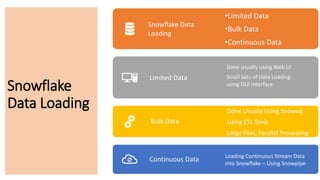
Snowflake Data Loading.pptx
- 1. Data Loading Snowflake Data Loading •Limited Data •Bulk Data •Continuous Data Limited Data Done usually using Web UI Small Sets of Data Loading using GUI Interface Bulk Data Done Usually Using Snowsql Using ETL Tools Large Files, Parallel Processing Continuous Data Loading Continuous Stream Data into Snowflake – Using Snowpipe Snowflake Data Loading
- 2. Data Loading - Bulk Copy •Data Loading Into Snowflake
- 3. Data Loading - Bulk Copy
- 4. Table Stage • Each table has a Snowflake stage allocated to it by default for storing files • This stage is a convenient option if your files need to be accessible to multiple users and only need to be copied into a single table User Stage • Each User has a stage allocated by default for storing Files • All the worksheets are stored in this stage • Will be accessed by single user • Will be useful if the same file needs to be copied to multiple tables • No Setting of File Format Options Internal Named Stage • Internal stages are named database objects that provide the greatest degree of flexibility for data loading • Users with the appropriate privileges on the stage can load data into any table. • Explicitly grant privileges on the stage to one or more roles before users with those roles can use the stage. External Stage • Stage to connect to AWS S3, Azure Blob, GCP Storage Snowflake Stages
- 5. Viewing Stages User Stage List @~; Table Stage List @%mytable Internal Named Stage List @my_stage_name External Stage List @external_Stage
- 6. Data Loading Data & File Formats 92-4, Ground Floor, beside Biryani Zone, Marathahalli, Bengaluru, Karnataka 560037
- 7. Data Loading Web UI LOGIN TO SNOWFLAKE ACCOUNT CLICK ON DATABASES MENU CLICK ON TABLE FOR WHICH YOU HAVE TO LOAD THE DATA YOU WILL SEE LOAD DATA MENU ON THE TOP OF TABLE COLUMN NAMES SELECT YOUR WAREHOUSE AND CLICK ON NEXT SELECT YOUR FILE FOR LOADING SELECT FILE FORMAT, IF NOT CREATED CREATE A FILE FORMAT (CHOOSE YOUR FILE FORMAT, NAME IT AND CREATE IT) AND CLICK ON NEXT SELECT YOUR LOAD OPTIONS AND LOAD THE FILE
- 8. Data Loading Bulk Copy Snowsql CREATE FILE FORMAT CREATE STAGE OBJECT STAGE THE DATA FILES BULK COPY DATA INTO TABLES VERIFY DATA PURGE STAGE DATA
- 9. Data Loading – File Format Data File Details
- 10. File Formats
- 11. Uploading Files To Stage Put file ://c:windowsemp.csv @~/myfolder Windows Put file:///userstempemp.csv @~/mystage -- Linux
- 12. Querying From Stage User Stage : Select (j.$1) from @~/mystage; Table Stage : Select ($1) from @%mytable; Internal Named Stage : Select t.$1,t.$2 from @my_stage_name t; Temporary Stage : Select t.$1 from @my_temp_stage_name t; 92-4, Ground Floor, beside Biryani Zone, Marathahalli, Bengaluru, Karnataka 560037
- 13. Data Loading – Transformation • Querying From Stage • Select $1,$2 From <@stage> (file_format=>’file format name’) • Transformations in Stage • Loading Subset Of Data • copy into home_sales(city, zip, sale_date, price) from (select t.$1, t.$2, t.$6, t.$7 from @mystage/sales.csv.gz t) file_format = (format_name = mycsvformat); • Include Sequence Columns in Loaded Data • Include AUTOINCREMENT / IDENTITY Columns in Loaded Data • create or replace table mytable ( col1 number autoincrement start 1 increment 1, col2 varchar, col3 varchar );
- 14. Bulk Copy
- 15. Bulk Copy..
- 16. Bulk Copy Copy Command Examples With Out Validation • Copy into <table Name> From <Stage> file_format=>file_format ON_ERROR = 'skip_file’ • Copy into <table Name> From <Stage> file_format=>file_format ON_ERROR = 'abort_statement’ • create or replace table save_copy_errors as select * from table(validate(mycsvtable, job_id=>'<query_id>')); Loading With SQL Statement • COPY INTO EMP FROM (SELECT $1,$2,$3,$4, TO_DATE($5,'YYYYMMDD'), $6,$7 FROM @MY_S3_STAGE/ (file_format => 'MY_CSV_FORMAT') ) ON_ERROR = CONTINUE;
- 17. Data Loading – Bulk Copy Steps •Bulk Copy Steps 1. Log into Snowflake using snowsql • snowsql -a <account Name> - u <user name> 2. Set Database, Virtual Ware house • Use database <database name> 3. Set Schema • use schema <Schema Name> 4. View Tables in the Schema Show Tables • Show stages 5. List User Stage • list @~; 6. List Named Stage • list @my_stage; 7. No Stages : Create a Stage / Temporary Stage
- 18. Data Loading – Bulk Copy Steps 8. Create Stages • create or replace stage my_int_stage copy_options = (on_error='skip_file'); • create or replace temporary stage my_temp_int_stage; • create or replace temporary stage my_int_stage file_format = my_csv_format; 9. List Table Stage • list @%<table name> 10. View File Formats • show file formats; 11. Put your file into Stage • put file://<file Path> <target Stage> 12. View if the File is Staged • List <Stage Name> 13. Bulk Copy Into Table • copy into table from @<stage > file_format = csv_format;
- 19. Data Loading – Bulk Copy Steps Step 9. Congratulations! Step 8. Remove the Successfully Loaded Data Files Step 7. Verify the Loaded Data Step 6. Resolve Data Load Errors Related to Data Issues Step 5. Copy Data into the Target Tables Step 4. List the Staged Files (Optional) Step 3. Stage the Data Files Step 2. Create Stage Objects Step 1. Create File Format Objects